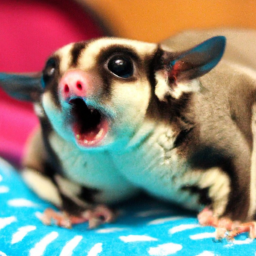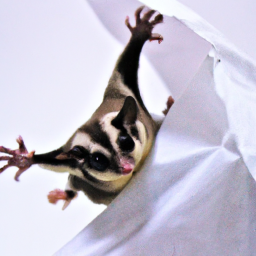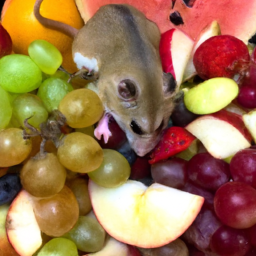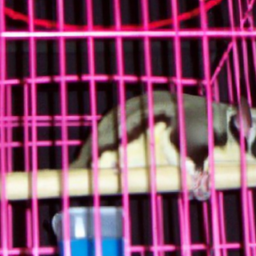Why Is Sugar Glider Barking
Hey there! Have you ever wondered why your sugar glider is barking? It can be a bit confusing, especially if you’re new to owning one of these adorable little creatures. Well, fear not! In this article, we’ll dive into the world of sugar glider barking and unravel the mysteries behind this behavior. Whether you’re a seasoned sugar glider owner or just starting out, you’re sure to find some valuable insights that will help you better understand your furry friend.
Curious to know why your sugar glider barks and what it means? Well, you’re in luck! In this article, we’ll explore the various reasons why sugar gliders bark, ranging from simple communication to more complex emotions. We’ll also discuss how you can respond to your glider’s barking and provide the best care possible. So, if you’ve ever found yourself wondering why your sugar glider is making those cute little barks, stay tuned and get ready to learn more in this informative article. We’ve got you covered!
Understanding Sugar Gliders
What are Sugar Gliders?
Sugar gliders are small marsupials native to Australia, Indonesia, and New Guinea. These adorable creatures get their name from their affinity for sugary foods and their ability to glide through the air. They are highly social animals and are often kept as pets due to their cute appearance and playful nature.
Characteristics of Sugar Gliders
Sugar gliders have a unique appearance, with soft fur ranging in color from gray to brown, a pointed face, and large eyes. They have a specialized membrane, called a patagium, that extends from their wrists to their ankles, allowing them to glide effortlessly through the trees. They also have a long, bushy tail that helps them balance during their acrobatic flights.
Behavior Patterns of Sugar Gliders
Sugar gliders are nocturnal animals, meaning they are most active during the night and sleep during the day. They are highly social creatures and live in colonies, forming strong bonds with their fellow gliders. These animals communicate with each other through various vocalizations, including barking.
Introduction to Sugar Glider Barking
What is Barking in Sugar Gliders?
Barking, also known as crabbing, is a vocalization commonly exhibited by sugar gliders. It is a high-pitched sound that resembles the barking of a small dog, hence the name. Gliders bark to communicate various messages to their colony members, as well as to express their emotions and needs.
Importance of Barking in Sugar Gliders
Barking plays a crucial role in the social dynamics of sugar glider colonies. It helps them establish dominance, mark territory, and signal danger or distress. Understanding the reasons behind sugar glider barking is essential for their caregivers to ensure their well-being and promote a harmonious environment.
Common Triggers for Barking in Sugar Gliders
Several factors can trigger sugar gliders to bark. It is important to recognize these triggers to better understand their behavior and address their needs appropriately. Some common triggers for barking in sugar gliders include:
-
Interaction with unfamiliar gliders: Sugar gliders may bark when interacting with unknown or unfamiliar gliders. This is a natural reaction as they establish their social hierarchy and indicate their dominance.
-
Environmental changes: Any sudden changes in the gliders’ environment, such as a new cage setup or relocation, can be stressful and lead to barking as the gliders adjust to the new surroundings.
-
Loud noises: Sugar gliders have sensitive hearing, and loud noises can startle and disturb them, leading to barking as a response to the perceived threat or disturbance.
-
Temperature extremes: Drastic temperature changes, either too hot or too cold, can cause discomfort to sugar gliders, resulting in barking as an indication of their distress.
Communicative Nature of Sugar Gliders
Methods of Communication in Sugar Gliders
Sugar gliders have a unique repertoire of communication methods to interact with their colony members. Apart from barking, they use various vocalizations, body language, scent marking, and even tactile communication to convey their messages.
The Role of Barking in Sugar Glider Communication
Barking serves as an essential form of communication among sugar gliders. It can convey different messages depending on the context and tone of the bark. Gliders use barking to establish dominance, defend their territory, warn others of potential threats, seek attention, or express discomfort and fear.
Other Vocalizations by Sugar Gliders
In addition to barking, sugar gliders produce various other vocalizations for communication purposes. These include chirping, hissing, purring, and even soft, melodic sounds called “crab calls.” Each vocalization carries a specific meaning and helps the gliders convey their emotions and needs effectively.
Understanding the Purpose of Barking
Alarm or Warning Signals
One of the primary purposes of barking in sugar gliders is to alert other members of the colony about potential dangers in their environment. When they sense a threat, they emit loud barks to warn their companions and elicit a coordinated response to protect the group.
Marking Territory
Barking also serves as a means of territorial marking for sugar gliders. By vocalizing their presence and dominance in a specific area, they establish boundaries and prevent conflicts with other gliders. This territorial behavior helps maintain order and minimize aggression within the colony.
Expressing Discomfort or Fear
Sugar gliders may bark when they feel uncomfortable or frightened. This could be due to handling that they dislike, an unfamiliar or stressful situation, or the presence of a predator or perceived threat. Barking in such instances acts as an expression of their fear or discomfort to communicate their need for reassurance or removal from the stressful situation.
Environmental Factors and Barking
Effect of Noise on Sugar Glider Barking
Noise can have a significant impact on sugar glider behavior, including their barking patterns. Loud or sudden noises can startle gliders and trigger barking as a response to the perceived threat or disturbance. It is important to provide a quiet and calm environment for sugar gliders to minimize their stress and promote a peaceful atmosphere.
Lighting and Barking Behavior
Lighting conditions also play a role in sugar glider barking behavior. Gliders are naturally nocturnal animals, and excessive exposure to bright lights during their active hours can disrupt their natural rhythms and induce stress. Maintaining a dimly lit environment during their active periods can help alleviate potential barking caused by stress or discomfort.
Temperature and Barking Patterns
Extreme temperatures can affect sugar glider behavior, including their barking patterns. Gliders may bark more frequently if they are too hot or too cold, as they try to communicate their discomfort. Maintaining a suitable temperature range in their habitat is crucial to prevent stress-related barking and ensure their well-being.
Social Interactions and Barking
Barking in Dominance Displays
Barking plays a significant role in social interactions among sugar gliders, particularly during dominance displays. When two gliders compete for dominance, they may bark at each other to assert their position and establish the hierarchy within the colony. Barking in this context is a vocal expression of their strength and dominance.
Barking to Signal Social Hierarchy
Apart from dominance displays, sugar gliders also use barking to signal their social hierarchy within the colony. Higher-ranking gliders may bark more frequently to assert their authority and maintain order, while lower-ranking gliders may bark less often to show respect and submission.
Barking during Mating Displays
During mating displays, sugar gliders engage in various vocalizations, including barking, to communicate their availability and interest to potential mates. Male gliders often bark to attract female gliders and display their suitability as potential partners.
Health and Emotional Reasons behind Barking
Pain or Illness-related Barking
Barking can be an indicator of underlying health issues or discomfort in sugar gliders. If a glider suddenly starts barking excessively or exhibits other signs of distress, it is crucial to consider the possibility of pain or illness. Health problems such as dental issues, infections, or injuries can cause gliders to vocalize their discomfort through barking.
Stress or Anxiety-induced Barking
Sugar gliders are highly sensitive animals and can easily become stressed or anxious in certain situations. Barking can be a manifestation of their stress or anxiety, resulting from factors such as excessive noise, improper handling, lack of enrichment, or changes in their routine. Identifying and addressing the source of their stress is important to alleviate their barking behavior.
Barking as a Manifestation of Loneliness
Sugar gliders are social animals and thrive on companionship. If they are kept alone without a suitable glider companion, they may bark more frequently as a sign of loneliness and longing for social interaction. Providing them with a suitable companion can help reduce their barking and promote their well-being.
Handling Excessive Barking
Determining Normal vs. Excessive Barking
While barking is a natural behavior for sugar gliders, excessive or sudden changes in barking patterns may indicate underlying issues or distress. Observing the gliders’ behavior and comparing their barking frequency and intensity to their usual patterns can help determine if the barking is excessive and requires attention.
Addressing Environmental Factors
To address excessive barking in sugar gliders, it is essential to evaluate and modify their environment. Ensuring a calm and quiet living space, maintaining suitable lighting and temperature conditions, and minimizing potential stressors, such as loud noises, can help reduce their barking behavior.
Providing Mental and Physical Stimulation
Sugar gliders require mental and physical stimulation to thrive and minimize excessive barking. Providing them with plenty of toys, climbing structures, and opportunities for exercise can help keep them engaged and satisfied, reducing the potential for boredom-induced barking.
Consulting a Veterinarian
When to Seek Veterinary Help
If a sugar glider’s barking persists or is accompanied by other concerning symptoms, it is crucial to consult a veterinarian experienced in treating exotic animals. A veterinarian can examine the glider, perform necessary tests, and provide appropriate medical intervention if required.
Veterinary Techniques to Reduce Barking
Veterinarians may employ various techniques to help reduce excessive barking in sugar gliders, depending on the underlying cause. This could include providing pain relief for health-related issues, recommending behavioral modifications, or suggesting appropriate environmental adjustments to promote a stress-free environment.
Medical Conditions Affecting Barking Behavior
Certain medical conditions, such as dental problems, gastrointestinal issues, or respiratory infections, can directly affect a sugar glider’s barking behavior. Treatment of these conditions can alleviate their discomfort and subsequently reduce excessive barking.
Is Barking a Sign of Aggression in Sugar Gliders?
Barking is not usually a sign of aggression in sugar gliders. However, excessive sugar glider biting behavior can indicate stress or discomfort. It’s important to understand the reasons behind this behavior and address any underlying issues to ensure the well-being of your pet.
Can Biting Behavior Lead to Sugar Glider Barking?
Sugar gliders can resort to barking if they feel threatened or stressed. It’s important to understand how to stop sugar glider biting to prevent them from feeling the need to bark. Using positive reinforcement, handling them gently, and providing proper training can help curb biting behavior and reduce the likelihood of barking.
Conclusion
Understanding the complexities of sugar glider barking is key to providing a healthy and happy environment for these fascinating creatures. By recognizing the various triggers, roles, and underlying reasons behind their barking behavior, caregivers can ensure their gliders’ well-being and promote harmonious interactions within their colonies. By addressing environmental factors, providing mental and physical stimulation, and seeking veterinary help when needed, caregivers can successfully manage and minimize excessive barking, ultimately fostering a strong bond and a fulfilling life for their sugar gliders.




